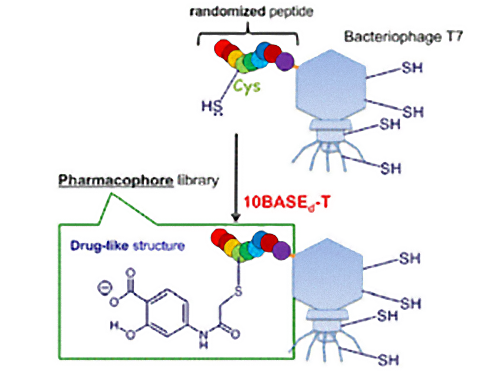June 2014 Issue
Research Highlights
Pharmacophores: The future of drug discovery
Developing new drugs that bind exclusively to target cells in diseases such as cancer is crucial. Masumi Taki and co-workers at the University of Electro-Communications in Tokyo, together with scientists at Kagoshima University, Japan, have expanded on current drug discovery methods to create a hybrid-drug generating system for this purpose.
Their system uses 'artificial-molecule evolution'- taking non-natural core molecules and adapting and optimizing them to make new 'pharmacophores'. A pharmacophore is a molecular model which can be manipulated to bind molecules for targets such as cancer cells.
Taki's team designed an artificial core molecule using salicylic acid, a readily available drug-like molecule known never to bind to a target protein on its own. They then used a common technique in drug discovery called 'phage display' to manipulate peptides to surround the artificial core molecule. Phage display involves inserting gene fragments into surface protein genes on bacteriophages - naturally-occurring viruses that infect bacteria. A new, non-natural protein or peptide hybrid then appears on the phage surface, and its biological properties can be exploited.
The researchers linked salicylic acid with a randomized peptide library, using T7 phages. The resulting pharmacophore could potentially interact with many different proteins via hydrophobic or hydrogen bonding, without losing phage infectivity or suffering side reactions. Pharmacophores generated from cheap, easy-to-produce artificial core molecules could hold great potential for the future of drug discovery.
Publication and Affiliation
Yuuki Tokunaga1, Yuuki Azetsu1, Keisuke Fukunaga1, Takaaki Hatanaka2, Yuji Ito2 & Masumi Taki1*. Pharmacophore generation from a drug-like core molecule surrounded by a library peptide via the 10BASEd-T on bacteriophage T7. Molecules 19 2481-2496 (2014)
- Department of Engineering Science, Bioscience and Technology Program, The Graduate School of Informatics and Engineering, The University of Electro-Communications (UEC), 1-5-1 Chofugaoka, Chofu, Tokyo 182-8585, Japan.
- Department of Chemistry and Bioscience, Graduate School of Science and Engineering, Kagoshima University, 1-21-35 Korimoto, Kagoshima, Kagoshima 890-0065, Japan
*corresponding author, e-mail address:



